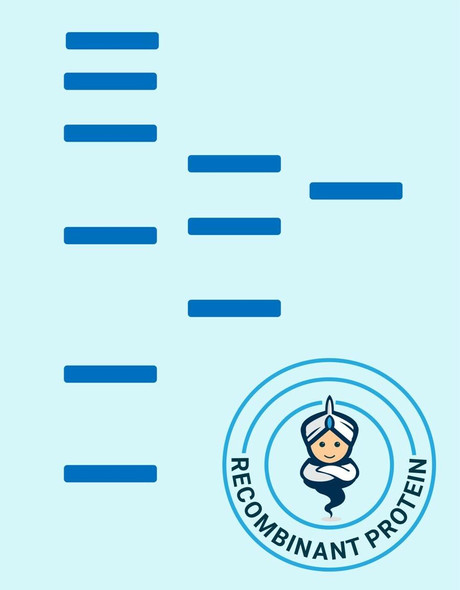Description
| Product Name: | Human HMGA1 Recombinant Protein |
| Product Code: | RPPB3695 |
| Size: | 10µg |
| Species: | Human |
| Target: | HMGA1 |
| Synonyms: | High mobility group protein HMG-I/HMG-Y, HMG-I(Y), High mobility group AT-hook protein 1, High mobility group protein A1, High mobility group protein R , HMGA1, HMGIY, HMG-R, HMGA1A. |
| Source: | Escherichia Coli |
| Physical Appearance: | Sterile filtered colorless solution. |
| Formulation: | HMGA1 protein solution (0.25mg/ml) containing 20mM Tris-HCl buffer (pH 8.0), 1mM DTT, 50% glycerol and 0.2M NaCl. |
| Stability: | Store at 4°C if entire vial will be used within 2-4 weeks. Store, frozen at -20°C for longer periods of time. For long term storage it is recommended to add a carrier protein (0.1% HSA or BSA).Avoid multiple freeze-thaw cycles. |
| Purity: | Greater than 90.0% as determined by SDS-PAGE. |
| Amino Acid Sequence: | MSESSSKSSQ PLASKQEKDG TEKRGRGRPR KQPPVSPGTA LVGSQKEPSE VPTPKRPRGR PKGSKNKGAA KTRKTTTTPG RKPRGRPKKL EKEEEEGISQ ESSEEEQLEH HHHHH |
High mobility group protein HMG-I/HMG-Y (HMGA1) belongs to the non-histone chromosomal high mobility group protein (HMG) family. HMGA1 is composed of a highly conserved AT-hook DNA-binding domain which mediates binding to AT-rich sequences in the minor groove of chromosomal DNA. HMGA1 functions as an architectural chromatin-binding transcription factor modifying the conformation of DNA by modulating nuclear protein-DNA complexes. Furthermore, HMGA1 is involved in numerous cellular processes including growth regulation, viral induction of beta-IFN gene and regulation of inducible gene transcription.
HMGA1 Human Recombinant produced in E.Coli is a single, non-glycosylated polypeptide chain containing 115 amino acids (1-107 a.a.) and having a molecular mass of 12.7kDa (Molecular weight on SDS-PAGE will appear higher).HMGA1 is fused to an 8 amino acid His-tag at C-terminus & purified by proprietary chromatographic techniques.
| UniProt Protein Function: | HMGA1: HMG-I/Y bind preferentially to the minor groove of A+T rich regions in double stranded DNA. It is suggested that these proteins could function in nucleosome phasing and in the 3'-end processing of mRNA transcripts. They are also involved in the transcription regulation of genes containing, or in close proximity to A+T-rich regions. A chromosomal aberration involving HMGA1 is found in pulmonary chondroid hamartoma. Translocation t(6;14)(p21;q23-24) with RAD51B. Belongs to the HMGA family. 3 isoforms of the human protein are produced by alternative splicing. |
| UniProt Protein Details: | Protein type:DNA-binding Chromosomal Location of Human Ortholog: 6p21 Cellular Component: nucleoplasm; transcription factor complex; focal adhesion; cytosol; nucleus Molecular Function:retinoid X receptor binding; peroxisome proliferator activated receptor binding; protein binding; enzyme binding; DNA-(apurinic or apyrimidinic site) lyase activity; DNA binding; ligand-dependent nuclear receptor transcription coactivator activity; AT DNA binding; retinoic acid receptor binding; 5'-deoxyribose-5-phosphate lyase activity; transcription factor binding Biological Process: DNA unwinding during replication; viral reproduction; transcription, DNA-dependent; positive regulation of transcription, DNA-dependent; response to virus; DNA catabolic process, endonucleolytic; negative regulation of cell proliferation; regulation of transcription, DNA-dependent; nucleosome disassembly; negative regulation of chromatin silencing; base-excision repair; protein complex assembly; negative regulation of transcription, DNA-dependent |
| NCBI Summary: | This gene encodes a non-histone protein involved in many cellular processes, including regulation of inducible gene transcription, integration of retroviruses into chromosomes, and the metastatic progression of cancer cells. The encoded protein preferentially binds to the minor groove of A+T-rich regions in double-stranded DNA. It has little secondary structure in solution but assumes distinct conformations when bound to substrates such as DNA or other proteins. The encoded protein is frequently acetylated and is found in the nucleus. At least seven transcript variants encoding two different isoforms have been found for this gene. [provided by RefSeq, Jul 2008] |
| UniProt Code: | P17096 |
| NCBI GenInfo Identifier: | 123377 |
| NCBI Gene ID: | 3159 |
| NCBI Accession: | P17096.3 |
| UniProt Secondary Accession: | P17096,P10910, Q5T6U9, Q9UKB0, |
| UniProt Related Accession: | P17096 |
| Molecular Weight: | 11,676 Da |
| NCBI Full Name: | High mobility group protein HMG-I/HMG-Y |
| NCBI Synonym Full Names: | high mobility group AT-hook 1 |
| NCBI Official Symbol: | HMGA1�� |
| NCBI Official Synonym Symbols: | HMG-R; HMGIY; HMGA1A�� |
| NCBI Protein Information: | high mobility group protein HMG-I/HMG-Y; HMG-I(Y); high mobility group protein R; high mobility group protein A1; nonhistone chromosomal high-mobility group protein HMG-I/HMG-Y; high-mobility group (nonhistone chromosomal) protein isoforms I and Y |
| UniProt Protein Name: | High mobility group protein HMG-I/HMG-Y |
| UniProt Synonym Protein Names: | High mobility group AT-hook protein 1; High mobility group protein A1; High mobility group protein R |
| Protein Family: | High mobility group protein |
| UniProt Gene Name: | HMGA1�� |
| UniProt Entry Name: | HMGA1_HUMAN |






